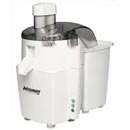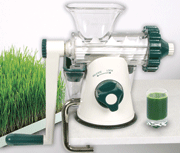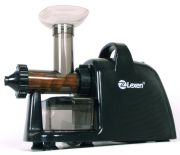Centrifugal Juicers Versus Masticating Juicers
When it comes to juicing, there are basically two types of juice machines that are available for you to choose from.
You can choose from centrifugal juice machines or masticating juicers.
Centrifugal Juicers
 Centrifugal means moving or directed away from a center or axis.
Centrifugal means moving or directed away from a center or axis.
A centrifugal juicer is the most common type of juicer you see in stores and on TV. A centrifugal juicer spins at high speeds and during the spinning motion, the vegetables that you have shoved down the chute are ground to a pulp. The spinning motion then forces the juice away from the pulp. The juice then pours into a bowl.
Masticating Juicers
 Masticating means to chew, to grind or knead into a pulp.
Masticating means to chew, to grind or knead into a pulp.
Your teeth are an excellent example of mastication in action. Your teeth chew and grind food. After you swallow, the food then goes to your digestive system which, through the process of digestion, begins to extract the juice from the food you eat.
Much in the same way, a masticating juicer grinds vegetables and literally squishes out the juice. Since a masticating juicer works at low speeds and with no spinning action, it tends to juice many vegetables more efficiently.
The Difference Between A Centrifugal Juicer and a Masticating Juicer
The difference between a centrifugal juicer and a masticating juicer is like night and day.
Centrifugal juicers work at high speeds, tend to be noisy and while a centrifugal juicer may be able to juice the rind of a pineapple more efficiently, in most situations, the low speed action of a masticating juicer allows you to juice more vegetables with greater efficiency. A masticating juicer tends to be a lot more quiet, less messy and easier to clean.
A masticating juicer is especially good at juicing the very important green leafy vegetables such as wheatgrass, spinach, parsley, cilantro, kale, Swiss Chard, etc. While a centrifugal juicer can juice green leafy vegetables, the centrifugal juicer is nowhere near as efficient as a masticating juicer in this regard.
Some say the high speed action of a centrifugal juicer produces too much heat which then can damage or possibly kill the enzymes in the juice. While I can neither confirm nor deny this statement, one thing is for sure, a masticating juicer definitely does not create the friction that a centrifugal juicer will create.
One significant benefit of a masticating juicer is that it requires less vegetables, in many situations, to create more juice. As a result, you spend less on vegetables than you would with a centrifugal juicer.
It's also worth noting that a masticating juicer is much more versatile, in many regards, compared to a centrifugal juicer. Since a masticating juicer squeeze the items you put into it, you can also use a masticating juicer to make baby food, fresh pasta, grind meat and to make nut butter.
What's My Preference?
 In the past, I've always used a centrifugal juicer. This is primarily because back when I started juicing, this was the only type of juicer that was readily available. I was also really impressed with Jay Kordich, aka "The Juiceman", who was my first real introduction to juicing. So when I started juicing, I used a Juiceman Jr.
In the past, I've always used a centrifugal juicer. This is primarily because back when I started juicing, this was the only type of juicer that was readily available. I was also really impressed with Jay Kordich, aka "The Juiceman", who was my first real introduction to juicing. So when I started juicing, I used a Juiceman Jr.
Today, my preference is to use a masticating juicer. I really enjoy the simplicity and versatility of a masticating juicer as mentioned above. I enjoy the ease of cleaning, the quality of the juice produced and I also really enjoy the fact that a masticating juicer is reasonably quiet.
If you are interested in a masticating juicer, then consider the masticating juicers made by Lexen Products.
Have you been wanting to do hatha yoga (stretching) but have found it either too difficult or you are not that flexible? If yes, and even if no, watch Jesse do some pure hatha yoga routines.
Unlike flow yoga
, each pose in pure or traditional hatha yoga is held for a few minutes. While holding the pose, you focus the mind on the stretch. When you focus the mind, that's when you find silence.
Jesse is not flexible — never has been and probably never will be flexible like others. But it doesn't matter. In pure hatha yoga, how flexible you are makes no difference. It's all about loving the pose and focussing the mind on the stretch.
If you want to learn pure hatha yoga, now you can by following Jesse on a series of hatha yoga routines.
Sponsored Links
Random Questions That Have Been Asked:
- Is It Okay To Mix Apples With Vegetable Juice?
- What Do You Recommend for high blood pressure and high cholesterol?
- Juicing strategy for overall health and wellness.
- Hypolycemia — blurred vision and tiredness while juicing.
- Juicing and Detoxification
- Can I freeze the juice and drink it later?
- Please comment on a report that says beet juice can improve exercise endurance?
- Juice Combination For Liver, Kidneys, Bile and Overall Health
- What is your take on juice fasting?
- Hypoglycemia, General Detox and Colds